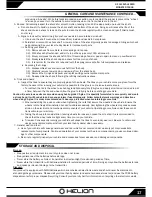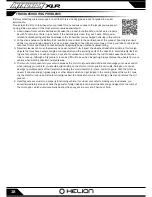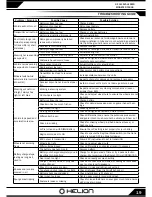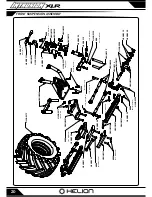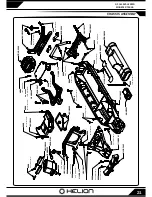
IKONNIK XENON HRS3.2 CONNECTION AND CONFIGURATION
6
NOTE: AS A SAFETY PRECAUTION, PERFORM THE FAIL-SAFE ADJUSTMENTS WITH THE VEHICLE’S WHEELS OFF THE
GROUND.
1. Turn the transmitter and receiver ON and move the throttle trigger to the desired position.
2. Press the Fail-Safe button for 5 seconds to program the throttle Fail-Safe setting. It is recommended and common to
set the throttle Fail-Safe as Full Brake, i.e. the throttle trigger is pressed completely forward applying full brakes. This
ensures that if the receiver cannot receive a signal from the transmitter, the servos or ESC will default to full brake
causing the vehicle to stop.
a. NOTE: WITH REVERSE MODE ACTIVE IN THE ESC, THE VEHICLE MAY GO INTO REVERSE THROTTLE INSTEAD OF
BRAKE WHEN THE TRIGGER IS PRESSED FORWARD. THIS IS THE CORRECT BEHAVIOR AND SETTING POSITION.
TO PREVENT WHEELS FROM TURING LIKE THIS, SIMPLY APPLY A LITTLE FORWARD THROTTLE, THEN FULL
BRAKES, THEN CONTINUE WITH THE FAIL-SAFE SETTING PROCEDURE.
3. To test the Fail-Safe settings, turn the transmitter off while the receiver is on. The servo/ESC will default to its pro-
grammed positions and the motor should not spin (assuming you have set the fail-safe to full brake).
4. Channel 1: Steering Servo
5. Channel 2: ESC (Throttle/Brake)
Note: An easy way to remember this is 1 to turn, 2 to burn (burn-out).
• Steering Trim
› Press the “ST+” or “ST-“ button to adjust the neutral position of the steering. A long “beep” will sound
› Once the trim setting reaches the limit, a long steady “beep” will sound
» Depending on your servo configuration, “ST+” or “ST-“ will move the servo either left or right. Use either “ST+”
or ST-“ to ensure the vehicle can track straight with no steering input
• Throttle Trim
› Press the “TH+” or “TH-“ button to adjust the neutral position of the throttle. A long beep will sound
› Once the value reaches the limit, a long steady “beep” will sound
» The throttle should be trimmed so the vehicle is stationary when no throttle input is applied
The channel reverse function reverses the direction of operation of the servos or ESC’s relative to the transmitter steer-
ing and throttle inputs. This function would be used if, for example, turning the transmitter steering wheel right resulted in
the model turning left and vice versa. Some ESC’s require that the throttle channel be reversed in order to program them
properly.
NOTE: AS A SAFETY PRECAUTION, PERFORM THE CHANNEL REVERSE ADJUSTMENTS WITH THE MOTOR UNPLUGGED
FROM THE ESC (CAUTION: DO NOT ALLOW THE WIRES TO TOUCH AFTER BEING DISCONNECTED WHILE PERFORMING
THIS SETUP PROCEDURE) AND THE WHEELS OFF THE GROUND.
• Steering Reverse:
› Turn the steering wheel completely to the left (or right) and press the “REV” button for at least 2 seconds to re-
verse the Steering (ST) channel.
› The transmitter will beep once for confirmation of “Normal” and twice for confirmation of “Reverse” setting.
• Throttle Reverse:
› Pull the throttle trigger completely to full throttle (or push forward for full brake) and press the “REV” button for at
least 2 seconds to reverse the Throttle (TH) channel.
› The transmitter will beep once for confirmation of “Normal” and twice for confirmation of “Reverse” setting.
Steering Dual-Rate (ST D/R):
Steering dual-rate allows on-the-fly end point adjustments to both sides (left and right) of the steering servo.
• The default value is 100% of the maximum servo travel. The dual-rate can be set from 20% to 100%.
› To increase the dual-rate, press the “DR+” button.
› To decrease the dual-rate, press the “DR-“ button.
End Point Adjustment:
• Steering End Point Adjustment (EPA)
› Use this function to adjust the left and/or right steering angle relative to the steering wheel position.
›
CAUTION: BE CAREFUL TO NOT OVER-EXTEND THE STEERING THROW AS IT CAN CAUSE YOUR SERVO TO OVER-
WORK AND OVER-HEAT.
› Steering-Left Side Adjustment:
» Turn the steering wheel completely to the left and use the “ST+” or “ST-“ buttons to adjust the steering angle
to the desired location.
› Steering-Right Side Adjustment:
» Turn the steering wheel completely to the right and use the “ST+” or “ST-“ buttons to adjust the steering angle

















